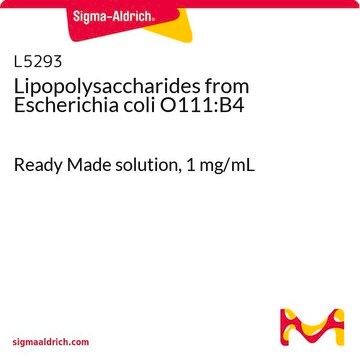SMB00704
Lipopolysaccharides from Proteus mirabilis
purified by phenol extraction
Synonym(s):
LPS
About This Item
Recommended Products
biological source
bacterial (Proteus mirabilis)
Quality Level
form
lyophilized powder
purified by
phenol extraction
impurities
<3.00% protein (Lowry-TCA)
color
white to faint yellow
solubility
water: 0.90-1.10 mg/mL, slightly hazy to hazy, colorless to light yellow
shipped in
ambient
storage temp.
2-8°C
General description
Proteus mirabilis is a Gram-negative facultative anaerobic rod-shaped bacterium. Bacteria of the genus Proteus of the family Enterobacteriaceae are opportunistic human pathogens responsible for wound and burn infections as well as skin, eye, ear, nose, throat, urinary tract, and gastrointestinal infections and bacteremias.
Application
- Lipopolysaccharide structure modulates cationic biocide susceptibility and crystalline biofilm formation in Proteus mirabilis.: The study explores how variations in lipopolysaccharide structure affect the susceptibility of Proteus mirabilis to biocides and its ability to form crystalline biofilms, informing strategies to combat biofilm-associated infections (Clarke et al., 2023).
Biochem/physiol Actions
Preparation Note
Other Notes
related product
Storage Class
11 - Combustible Solids
wgk_germany
WGK 3
flash_point_f
Not applicable
flash_point_c
Not applicable
Choose from one of the most recent versions:
Certificates of Analysis (COA)
Don't see the Right Version?
If you require a particular version, you can look up a specific certificate by the Lot or Batch number.
Already Own This Product?
Find documentation for the products that you have recently purchased in the Document Library.
Customers Also Viewed
Articles
Explore the structure, function, and diverse applications of Lipopolysaccharides. Discover their role in bacteria, serological specificity, and research potential.
Our team of scientists has experience in all areas of research including Life Science, Material Science, Chemical Synthesis, Chromatography, Analytical and many others.
Contact Technical Service


